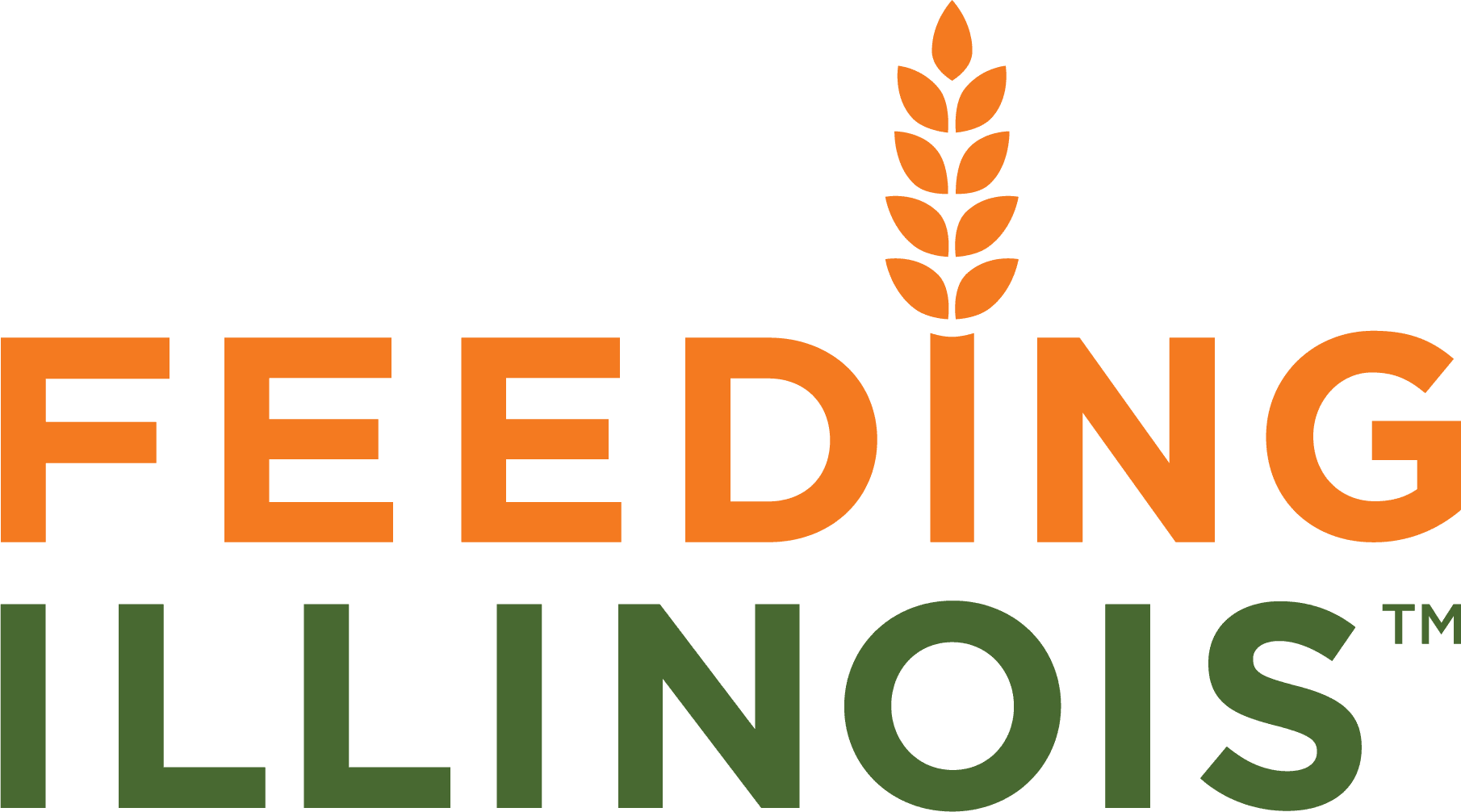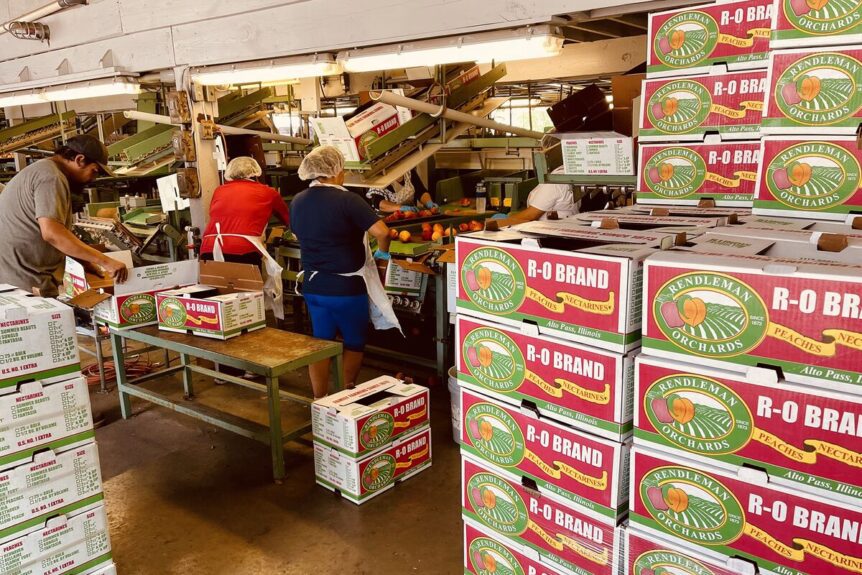Food banks in Illinois got a special treat last year: more than 600,000 pounds of peaches, nectarines and apples. Marred by a dimple here or there, the fruit was bounty that previously might have been left to rot, deemed unsuitable for grocery stores.
Instead, a three-year pilot program distributed tons of such fresh fruit to food pantries, shelters, senior centers and other groups serving people in need. The Farm to Food Bank project shores up local supply chains by creating another market for local growers, while also eliminating food waste and relieving hunger.
“We don’t often get peaches fresh off the tree — they’re like gold to us,” said Stephen Ericson, executive director of Feeding Illinois, which funds the program along with the US Department of Agriculture. Feeding Illinois is an association of eight large food banks that serve more than 3,000 pantries, soup kitchens and other aid providers. The need has perhaps never been more urgent, with the number of food-insecure households rising and US food prices surging the most since 1979 in July.
Nearly all of last year’s harvest came from Rendleman Orchards in Alto Pass, Illinois, more than five hours south of Chicago. Now, in the pilot’s second year, the farm is shipping fruit to food banks again, alongside a larger roster of local growers. In addition to peaches, food banks will also receive corn, summer squash, cabbage, peppers and eggplant. It’s a boon for service groups that want to distribute more fresh produce but normally rely on unpredictable retail donations. It’s also a bit of relief as farms and small businesses cope with ongoing challenges created by the Covid-19 pandemic.
The Farm to Food Bank program “is a breath of fresh air,” said Wayne Sirles, co-owner of the orchard, which was founded by his family in 1873 and provided the equivalent of more than 61,600 meals to food banks last year. “We have the option to sell our product at a fair price for people who need it.”
Across the US, about 38 million people were food insecure in 2020, the year the pandemic struck. In Illinois, about 1.3 million people were food insecure in 2020, or 12.7% of the population — up from 10.1% in 2018. The Farm to Food Bank program is expanding this summer at a time when food banks are strained by both swelling customer demand and a consumer price index that reached a 40-year high in June. Overall inflation eased a bit in July, but food prices continued to rise, jumping 10.9% from a year earlier.
“Budgets are being wiped out,” said Ericson, the Feeding Illinois director. “There’s a lot of anxiety about being able to maintain programs, let alone expand.”
While Farm to Food Bank was conceived before the pandemic, its goal has gained greater urgency due to soaring fuel prices and supply-chain backlogs exacerbated by Russia’s war in Ukraine. Those disruptions “revealed the perils of a national food system that depends on capacity concentrated in a few geographic areas,” the USDA said this June. “The food system of the future needs to be more distributed and local.”
Through Farm to Food Bank, local growers are paid for their produce and to pick, pack and ship it. Growers recoup costs and avoid food waste, while consumers get healthy food straight from the farm. “It’s such a win-win-win,” said Michelle Sirles, co-owner of Rendleman Orchards, which normally would have surplus produce go to waste, even after selling off-grade fruit for juicing and processing.
Each year, the US generates about 229 million tons of surplus food — unsold or uneaten food — worth $408 billion, according to nonprofit ReFED. Farms generate 21%, or 17 million tons, of that food. Some 45% of Illinois farmers leave unmarketable produce in the field and 61% are looking for other outlets for their goods, according to a 2021 survey by the Illinois Sustainable Technology Center (ISTC) at the University of Illinois.
One reason: It’s costly and time-consuming for farms to pick, pack and transport perishable surplus produce, especially with skyrocketing fuel prices and fewer workers. While some growers see it as more cost-effective to throw away the extra, the ISTC also reports that 55% of farmers said getting 5 cents to 30 cents per unit of surplus food would offset costs and make harvesting it worthwhile.
That makes it essential to aggregate and streamline produce deliveries. This year — in the middle of the three-year pilot — Rendleman Orchards is gathering fruit and vegetables from more nearby farms for weekly pickups or deliveries to large food banks such as the Greater Chicago Food Depository. That enormous warehouse is part of the Feeding Illinois network and is the distribution hub for smaller food pantries and aid programs in the area. Rendleman also makes weekly deliveries to other food banks in Illinois, as well as in Indiana and St. Louis.
“You need to haul volumes,” with produce packed in pallets and shipped in full truckloads to be efficient at a larger scale, Wayne Sirles said.
In Rendleman’s first shipment in the pilot last year, it delivered 48 cases of fruit in two pallets to the Tri-State Food Bank in southern Illinois near Indiana and Kentucky. Soon after, the St. Louis Area Foodbank sent empty trucks to pick up directly from the farm. Each week, Rendleman would contact food banks about product availability and then arrange pickup or delivery that fit with the farm’s existing operations. Northern Illinois Food Bank in Geneva and Greater Chicago Food Depository also joined the program.
Farm to Food Bank’s goal in Illinois is to become a sustainable, long-term program funded by a mix of government and philanthropic sources, like established ones in more than a dozen states such as California, Kentucky, Ohio and Pennsylvania. Since 2005, California’s program has delivered more than 160 million pounds of produce to state food banks. Some 240 farmers, packers and distributors participate annually. Kentucky’s Farms to Food Banks program was piloted in 2009 and then launched statewide in 2011. Since 2011, more than 11 million pounds of fresh produce from over 800 farmers have been distributed to Kentuckians.
In focus groups, Illinois farmers underscored the need for aggregation hubs to be efficient. Centers such as big food banks could also provide cold storage for farms without those facilities. This year, Farm to Food Bank is also partnering with farmers markets as aggregation hubs.
Local produce in greenmarkets is typically more expensive than food at groceries from large industrial farms. But with higher fuel and labor costs all around, that price difference is shrinking, said Raghela Scavuzzo, an associate director at the Illinois Farm Bureau, another Farm to Food Bank partner.
Now instead of relying on produce shipped 1,500 miles or more across the country, Illinois food banks can draw from farms closer to home, with fewer potential supply-chain blockages. While the need to shift supply chains was recognized before the pandemic, Covid-19 made it more urgent, just as it did with the demand for local food. “That uptick is sticking,” she said. “It’s not going away.”

